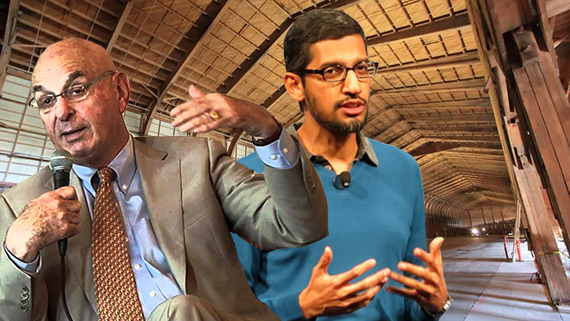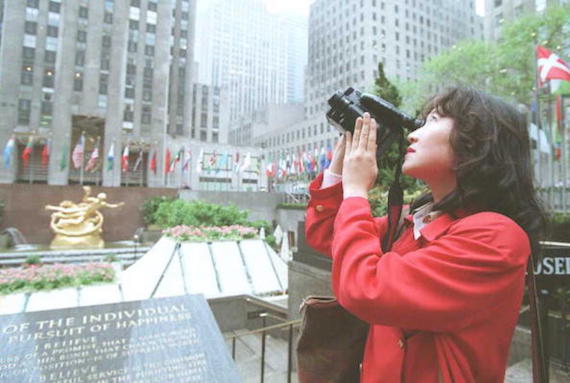UPDATED, 3:15 p.m., Jan. 4: Until last month, all the Japanese conglomerate ASO Group had done in the U.S. was manufacture adhesive bandages in Florida.
Now, the global infrastructure company, whose revenues topped $2 billion in fiscal year 2016, is the owner of one of L.A.’s most high-profile real estate assets, the Google-leased Spruce Goose hangar, which it bought for between $300 million and $320 million late last month. And that may be just the beginning, since the company is looking to make other real estate investments in California, its broker told The Real Deal.
It caught the real estate industry by surprise that ASO, the second-largest producer of adhesive bandages in the world and a virtual unknown in the U.S., made such a major investment in L.A. Even more surprising was that the company hailed from Japan, a country that has done little to no real estate investing in the L.A. market in decades. Sources told TRD that the hangar deal may be evidence of a renewed demand for L.A. properties from Japanese investors.
“[This] could be a banner year for Japanese institutional giants in terms of investing in U.S. core real estate,” said Michael Maduell, president of the Sovereign Wealth Fund Institute.
Indeed, the Japanese have been almost absent from the L.A. market since the 1990s, when they got burned badly in the U.S. amid an economic downturn. At the lowest point of the crisis, Japan’s Shuwa Investment Corporation out of Tokyo struggled under the weight of $10 billion in debt accumulated through its purchase of ARCO Plaza complex in Downtown L.A., as well as several properties in Washington D.C.
But over the past two years, there have been signs of life as Japanese investors began to seek greater returns amid low interest rates at home and looked to the U.S. as a safe haven for their money.
“Mired in negative interest rates, Japanese public funds and insurers are on the hunt for yield and are willing to accept lower rates of return than their U.S. pension peers in some instances,” Maduell said. “These allocators of capital will mostly target office properties in core markets. Don’t expect Japanese pensions to invest in Pebble Beach.”
So far, the renewed enthusiasm has largely seen the yen make its way to New York.
In 2014, Japanese conglomerate Mitsui Fudosan Group made a $259 million investment in the Related Companies’ 55 Hudson Yards on Manhattan’s Far West Side. In 2015, Unizo (formerly Jowa Holdings), nabbed 370 Lexington Avenue for $247 million and the Tokyu Land Corporation — whose first U.S. real estate investment was the acquisition of a stake in 425 Park Avenue in Midtown Manhattan — recently opened an office in El Segundo to headquarter their U.S. operations, which will include “aggressive” investments in Los Angeles and Houston, according to the firm’s website.
“Few Japanese investors were buying real estate until recently; the market has been picking up,” said Christopher Okada, the president of Okada & Company, a New York-based real estate firm which works with Japanese investors.
Mitsui Fudosan, however, is an exception. Unlike many of its industry peers, the firm remained quietly active in the U.S. following the 1990s fallout and is currently planning a 43-story, 430-unit residential tower in Downtown L.A. on the corner of 8th and Figueroa Streets.
Some of the biggest Japanese names slated to take a bite out of U.S. real estate in 2017 include the world’s largest pension fund, Government Pension Investment Fund, and Japan Post Holdings Co., according to a report by the Sovereign Wealth Fund Institute. GPIF made headlines when its equities portfolio lost $52 billion in value in the second quarter of 2015 following a stock rout. Its remaining roughly $1 trillion in assets do not yet include any real estate investments in the U.S.
As for Japan Post, after a massive three-pronged IPO in 2015, the company hired Katsunori Sago, a former Goldman Sachs Japan executive, to steer the reallocation of its $2 trillion in assets. Sago is expected to prioritize real estate, among other asset types.
None of the firms immediately responded to requests for comment on their U.S. investment plans.
Okada described the 1980s as the heyday for his father, Naomi Okada, who built his career bringing Japanese clients into New York. In 1986, the New York Times reported that Japan had overtaken Britain to become the largest foreign real estate investor in the U.S. By 1988, when Japanese investment in the U.S. hit $16.54 billion, L.A. was also top of Japan’s wish list. At its peak, Shigeru Kobayashi and his Shuwa Investment Corporation owned 40 percent of Downtown L.A.’s office buildings, thanks to the record-breaking $640 million Arco acquisition in 1986. That sale topped even the $610 million Mitsui Fudosan paid for the Exxon building in the Rockefeller Center complex in New York.

Ratkovich CEO Wayne Ratkovich, Google CEO Sundar Pichai and the Spruce Goose hangar at 5865 South Campus Center Drive (Credit: Youtube, Search Engine Land and Playa Vista Home Sales)
But by 1991, the buying binge was over: rents in the U.S. collapsed and vacancies were up. In 1995, Mitsubishi Estate Co., which had bought an 80 percent stake in the Rockefeller Center, filed for bankruptcy protection, engaging in a battle with the Rockefeller family for ownership of the complex. An 80-year-old David Rockefeller reportedly broke his leg near the Imperial Palace in Tokyo on his way to the Mitsubishi office during a last-ditch, and ultimately futile, attempt to save the symbol of his family’s prestige from humiliation.
When Shuwa decided to sell ARCO in 1999, bids for the company’s 8.5-million-square-foot portfolio did not exceed $1.5 billion, roughly half what they paid for it. The Kobayashi investments were reportedly blamed in part for L.A.’s overbuilt downtown. Shuwa finally managed to sell Arco for $270 million, less than half its price 16 years prior.
In recent years, the Japanese have barely moved the needle in terms of investment, being overshadowed by their Chinese and Canadian counterparts. Chinese investors acquired at least $17.1 billion of existing commercial property between 2010 and 2015, an annual growth rate of 70 percent, according to the Asia Society, with the Canadians close behind. The Japanese have not ranked on most foreign investment reports. Japanese investment in U.S. real estate this year totaled just $2.3 billion in the last year, according to Real Capital Analytics.
But that might eventually change, though nobody seems to anticipate a return to Japan’s ’80s-era appetite for U.S. real estate.
“This time it’s different, people are taking their time looking for yields rather than prestige,” Okada said.
Eastgate’s Reid Mackay, who represented ASO Group in its recent acquisition of the hangar, said small private investors may not be as visible as the big traditional institutional investors, but are going to be just as significant in the U.S. market going forward.
“They will be chasing bond-like investments rather than the trophies,” he said. “Japanese scale is not going to be anywhere like previous levels, but will be very strategic.”
Correction: A previous version of this story mischaracterized the size of ASO Group. Its revenues in Fiscal Year 2016 were over $2 billion.
